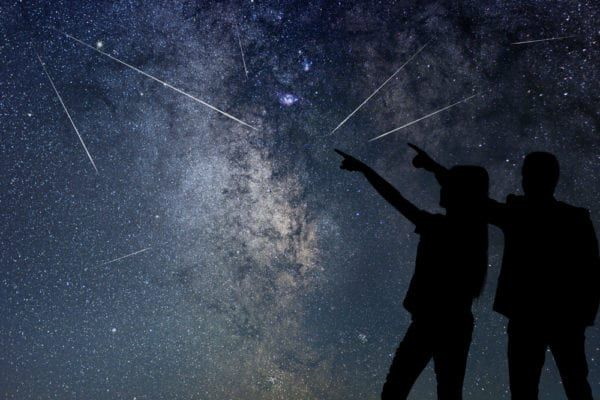Editor’s note: Some details were compiled by Jamie Carter for Forbes Magazine.
 Remember the excitement of gazing across the night sky, following the glittery trajectory of a shooting star? Prepare to view hundreds of them this month, during three overlapping meteor showers, set atop the Milky Way Galaxy.
Remember the excitement of gazing across the night sky, following the glittery trajectory of a shooting star? Prepare to view hundreds of them this month, during three overlapping meteor showers, set atop the Milky Way Galaxy.
As with all meteor showers, the rate is greatest in the predawn hours, because the side of the Earth nearest to turning into the sun scoops up more meteors as the Earth moves through space.
The visible path of a meteoroid that enters Earth’s atmosphere is called a meteor, or colloquially a “shooting star” or “falling star.” It is followed by a trail of glowing gases. A meteor shower is a celestial event, in which a number of meteors are observed to radiate from one point in the night sky. These meteors are caused by streams of cosmic debris, called “meteoroids,” entering Earth’s atmosphere, at extremely high speeds on parallel trajectories. Most meteors are smaller than a grain of sand, so almost all of them disintegrate and never hit the Earth’s surface.
When to see the Milky Way: beginning at 11:00 p.m.
Dark, moonless night skies that a New Moon signifies are the best time to see the Milky Way Galaxy in summer. It is best from about 11:00 p.m., when it is arching across the night sky. You need to be under a dark sky, anywhere away from light pollution.
When to see the Perseids meteor shower: anytime until about August 6/7, through Saturday, August 24.
Usually, the Perseids meteor shower is the easiest to see. However, in 2019 a waxing, bright First Quarter moon will get in the way and blot out many of them during the peak time, early morning of Monday, August 12. The best tactic is to look for Perseids before and after the peak. The shower runs through Saturday, August 24, so look anytime until about August 6/7 before the moon gets too bright. Look vaguely to the northeast in the direction of the constellation of Perseus, although Perseid shooting stars can appear anywhere in the night sky. During the peak, the rate of meteors will reach 60 or more per hour. One meteor streak per minute will offer lots of active viewing!
 When to see the Delta Aquarid meteor shower: until Friday, August 23.
When to see the Delta Aquarid meteor shower: until Friday, August 23.
Best seen by looking generally to the south in the direction of Aquarius, the Delta Aquarids meteor shower will continue until Friday, August 23. Its shooting stars can appear anywhere in the night sky. From about midnight through 4:00 a.m., the Delta Aquarid meteor shower ought to produce about 20 shooting stars per hour; most of them are fairly faint.
When to see the Alpha Capricornids shower: until Friday, August 23.
Peak viewing ended in July, but the Alpha Capricornids meteor shower will continue until Friday, August 23. Only five shooting stars per hour is typical from this minor display, viewable by looking generally south. Look for the constellation of Capricorn–a tricky one to find–and you might spot one of its shooting stars.
“What is notable about this shower is the number of bright fireballs produced during its activity period,” advises the American Meteor Society.
